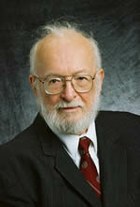Paul C. Lauterbur received the Dr A.H. Heineken Prize for Medicine 1989 for his invention of MRI (magnetic resonance imaging), a groundbreaking medical technology allowing precise and comprehensive imaging of the human body.
In 1945 Bloch and Purcell discovered the phenomenon of nuclear magnetic resonance: the ability of atomic nuclei to resonate at a particular frequency when they are subjected to a magnetic field. This is the basis of MRI. Various methods of image reconstruction have been invented and many researchers have contributed to the development of the techniques and its applications. Lauterbur’s invention was basic to all subsequent developments. During the years after 1973, rapid development took place. The medical applications could only really take off after very large magnets became available in which a patient could be situated. For sensitivity reasons the magnetic field must be high; most useful ‘whole-body magnets’ are made of superconducting material kept at a temperature of 269 degrees Celsius below zero. Such magnets have only become routinely available in recent years and have caused an explosion in the spread of magnetic resonance imaging equipment for medical purposes.
The importance of magnetic resonance imaging for medical applications is not just a result of the ability to see the distribution of water in tissue. In his 1973 article Dr Lauterbur already envisioned such important applications as discriminating tumours from normal tissue. Not only did he envision the medical applications, he also devoted his further career to the development of the method. At Stony Brook, and later as Director of the Biomedical Magnetic Resonance Laboratory of the University of Illinois at Urbana-Champaign, Dr Lauterbur has contributed substantially to the methods and applications of nuclear magnetic resonance imaging in medicine.
About the laureate
Paul C. Lauterbur was born on May 6, 1929 in Sidney, Ohio, USA. In 1951 he graduated from the Case Institute of Technology, Cleveland, Ohio, and, after working at the Mellon Institute, where he did the first NMR spectroscopy on 13-C and several other nuclei, he obtained his Ph.D. in Chemistry from the University of Pittsburgh in 1962. He then became Associate Professor of Chemistry at the State University of New York at Stony Brook, New York, where his research interests concerned the applications of nuclear magnetic resonance in chemistry, biochemistry and biophysics. During this period he developed the magnetic resonance imaging method, which he called ‘zeugmatography’ and studied its applications to medicine. This contribution has initiated further developments in the application of magnetic resonance imaging in medicine, which became very significant when so-called ‘whole-body magnets’ became available. In 1984 Dr Lauterbur became University Professor at Stony Brook. In 1985 he left Stony Brook to direct the Biomedical Magnetic Resonance Laboratory at the University of Illinois at Urbana-Champaign, Illinois, where he also became professor in the Department of Medical Information Science, College of Medicine, and in the Department of Chemistry. Later appointments include professorships at the Center for Advanced Study, of Biophysics, and of Bio-engineering, all at the University of Illinois at Urbana-Champaign.
Dr Lauterbur has received nine honorary doctorate degrees: including from the University of Liege (1984), from the Carnegie Mellon University in 1987, and from the Nicolaus Copernicus Medical Academy, Cracow, Poland, in 1988. He is a member of the National Academy of Sciences (USA) and has received numerous awards and prizes, both national and international, among which are the Albert Lasker Clinical Research Award (1984), the Harvey Prize in Science and Technology, Technion, Israel (1986). The Roentgen Medal (1987), The National Medal of Science (1987), and the Fiuggi International Prize (1987). In 2003 he won the Nobel Prize in Physiology or Medicine together with Sir Peter Mansfield.
Lauterbur passed away in March 2007.
